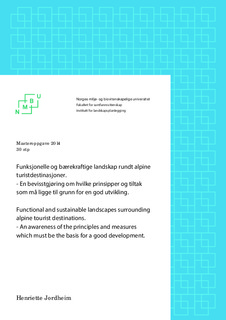| dc.description.abstract | Reiselivsnæringen er en av verdens raskest voksende næringer (NHD 2012), og i Norge satses det flere steder på store utbygginger av alpinanlegg med tilhørende infrastruktur, selveierhytter og overnattingsplasser med høy standard.Ved utbyggingen av større alpinanlegg blir vi også vitne til en nedbygging av natur og kulturlandskap. Slike endringer i landskapet fører også til en endring i landskapets funksjoner, som gjøre det mer sårbart i forhold til å levere oss viktige tjenester i fremtiden. Det vil være viktig å se på hvordan en utvikling av turisme i mindre fjellbygder kan være med å bygge opp om levedyktige steder, som tar vare på det stedegne og lokale, samtidig som man tilrettelegger for økt næringsliv og turisme (InnovasjonNorge 2014 b).
I denne oppgaven har jeg tatt utgangspunkt i følgende problemstillinger:
Hvordan skape funksjonelle og bærekraftige landskap rundt utbygging av større alpinanlegg, som kan ivareta og styrke landskapets særpreg og funksjonalitet ?
Hvilke prinsipper bør ligge til grunn for en god utvikling av landskap og turistbygder rundt større alpinanlegg?
Hvilke landskapstilpasninger vil være nødvendig for å sikre naturmiljøet, kulturarven og landskapets særpreg for fremtiden i utviklingen av større turistdestinasjoner?
For å få svar på disse problemstillignene var det viktig å se på hva litteratur og forskning sier om tema. I tillegg til et dokumentstudie på nasjonalt og regionalt nivå, dannet dette grunnlaget for den videre undersøkelsen og diskusjonen i oppgaven. Myrkdalen fjellandsby har vært et eksempelområde for oppgaven, og jeg har sammenliknet området med liknende prosjekter i Norge og Europa. Jeg har også gjennomført intervjuer med forskjellige fagpersoner i tilknytning til temaene; bærekraftige landskap og turistdestinasjoner.
På bakgrunn av resultater og innhentet kunnskap fra oppgaven, konkluderer den med at det er viktig å jobbe for en opprettholdelse av landskapets ressurser, da de er med på å gi oss grunnleggende goder og tjenester innenfor et variert biologisk mangfold, gode vekstmuligheter for jordbruksproduksjon, og opplevelsesverdier gjennom et rikt kulturlandskap eller ved utøvelse av friluftsliv og andre aktiviteter.
Å jobbe for at kulturlandskapet og stedets særpreg opprettholdes er essensielt for en bærekraftig utvikling av landskapet. Økt tilrettelegging for friluftsliv og natur- og kulturopplevelser vil gi landskapet rundt utviklingstedet en større felles verdi for turister og lokalbefolkning. Skal en kunne oppnå en bærekraftig utvikling rundt et alpinanlegg er reell medvirkning fra lokalsamfunn og andre berørte aktører en nøkkelfaktor. Dette har vist seg å være utfordrende da lokalsamfunnet ofte står opp mot en større kapital, som kan være overstyrende og ønsker en rask utvikling. Det er derfor viktig å få til et samarbeid gjennom en felles plattform og knytte utviklingen opp mot felles mål og visjoner, med bakgrunn i et sterkt kunnskapsgrunnlag.
Avslutningsvis presenterer jeg noen landskapstiltak som kan føre til en forbedring av dagens landskap og en opprettholdelse av stedets verdier i tilknytning til større turistdestinasjoner.
Abstract
Tourism is one of the fastest growing industries in the world (NHD 2012), and in Norway it is big buisness to construct alpine resorts connected to high standard infrastructure, private cabins and lodging. When constructing larger alpineresorts results are often a reduction in nature and cultural landscape. These environmental changes also lead to changes in the functionality of the landscape, which makes it less capable of producing important services in the future. It will be important to observe how tourist growth in small mountain villages can be a part of building livable places, while maintaining its local distinctiveness and facilitating buisness and tourism (InnovasjonNorge 2014b).
As a starting point for this master thesis I have been examining the following issues:
How to establish and develop larger alpine resorts, which maintain and strengthen the character and function of the landscapes?
Which principles should be fundamental to ensure a positive development of landscapes and tourist villages surrounding larger alpine resorts?
Which landscape adjustments will be nessasary to ensure the natural environment, cultural heritage and landscape distinctiveness for future development of larger tourist destinations?
In order to answer these issues it was essential that I looked into what litterature and science say about the subject. As a supplement I looked into a document study covering national and regional level, which formed a basis for further research and discussion for the master thesis. Myrkdalen mountain village has been set as an example for this master thesis, and I have compared it to similar projects in Norway and Europe. I have done interviews with different proffesionals connected to subjects concerning sustainable landscape and tourist destinations.
Based on results and gathered knowledge from the thesis, it concludes that it is important to strive towards maintaining the landscape resources, which deliver fundamental goods and services within a varied biodiversity, good growth conditions for agricultural production, and experience value through a rich cultural landscape or through outdoor living and other recreational activities.
preserving the cultural landscape and the characteristics of place is essential for a sustainable development of the landscape. Increased facilitating for outdoor life, nature- and cultural experiences will give the landscape surrounding the place of development a greater common value for tourists and local inhabitants. In order to achieve a sustainable development around an alpine resort, real participation from local community and other affected actors is a key factor. This has proven to be challenging when the community often comes up against a major capital, which may be the overriding and want a fast development. That is why it is important to achieve a cooperation through a common platform and associate development towards common goals and visions, based on a strong foundation of knowledge.
In my conclusion I present some landscape measures which can lead to an improvement of the existing landscape, and a maintainment of the values associated to larger tourist attractions. | nb_NO |
